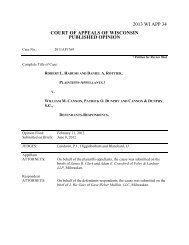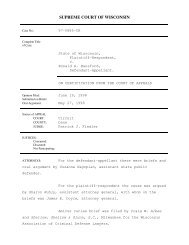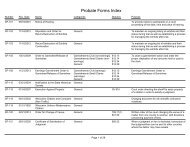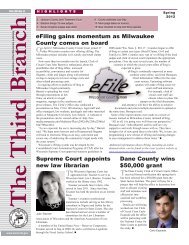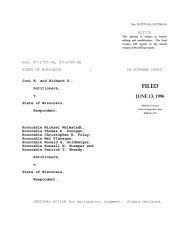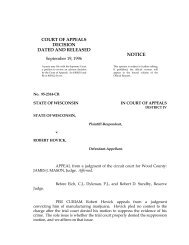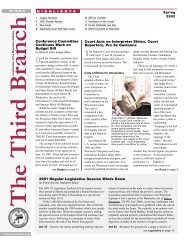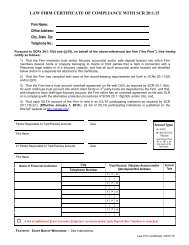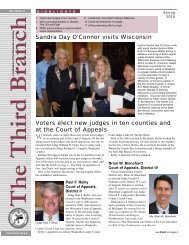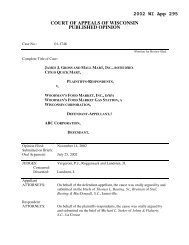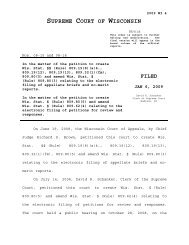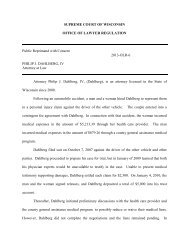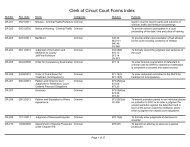Making the Record Committee - Final report - Wisconsin Court System
Making the Record Committee - Final report - Wisconsin Court System
Making the Record Committee - Final report - Wisconsin Court System
Create successful ePaper yourself
Turn your PDF publications into a flip-book with our unique Google optimized e-Paper software.
CHIEF JUDGES’MAKING THERECORDCOMMITTEEFINAL REPORTMay 2004<strong>Wisconsin</strong> Circuit <strong>Court</strong>s
<strong>Making</strong> <strong>the</strong> <strong>Record</strong> <strong>Committee</strong>MembersChief JudgeJames Evenson, ChairDeputy Chief JudgeJames R. Kieffer<strong>Court</strong> of Appeals JudgeDavid DeiningerCircuit <strong>Court</strong> JudgeJohn A. DamonManaging <strong>Court</strong> ReporterKristine JacobiOfficial <strong>Court</strong> ReporterTeri Novotny HockersmithEdward H. Johnson (alternate)District <strong>Court</strong> AdministratorKathleen M. MurphyScott Johnson (alternate)Director of State <strong>Court</strong>s OfficeSheryl GervasiMargaret BradyPam Radloff (alternate)Director of State <strong>Court</strong>s Office StaffDeborah BrescollDaniel WassinkSauk CountyWaukesha CountyDistrict IV, MadisonTrempealeau CountyMilwaukee CountyMonroe CountyOzaukee CountyDistrict VIIIDistrict IXDeputy Director for <strong>Court</strong> OperationsHuman Resources OfficerDeputy Director for ManagementServicesBudget and Policy OfficerSenior Policy Analyst--PPAC
CHIEF JUDGES’ MAKING THE RECORD COMMITTEEMay 2004TABLE OF CONTENTS<strong>Making</strong> <strong>the</strong> <strong>Record</strong> <strong>Committee</strong> ............................................................................ 1Previous <strong>Court</strong> Reporting <strong>Committee</strong>s and Reports ............................................ 1<strong>Committee</strong> Mission Statement.............................................................................. 2Current <strong>System</strong> of <strong>Making</strong> <strong>the</strong> <strong>Record</strong> ................................................................ 2Future Trends........................................................................................................ 6Existing <strong>Court</strong> Reporter Workforce................................................................................... 6Recent Hires....................................................................................................................... 7Future <strong>Court</strong> Reporter Pool – National Statistics .............................................................. 8Future <strong>Court</strong> Reporter Pool – <strong>Wisconsin</strong> Statistics ........................................................... 9Recommendations................................................................................................. 10APPENDIX I Previous <strong>Court</strong> Reporting <strong>Committee</strong>s and Reports…………….. 17APPENDIX II Use of Alternative <strong>Court</strong> Reporting Technologies By Size ofCircuit…………………………………………………………………………… 23APPENDIX III NCRA/NVRA/AAERT Certification Programs .......................... 26
<strong>Making</strong> <strong>the</strong> <strong>Record</strong> <strong>Committee</strong>The Chief Judges created <strong>the</strong> <strong>Making</strong> <strong>the</strong> <strong>Record</strong> <strong>Committee</strong> at <strong>the</strong>ir June 13, 2003meeting to look at alternatives and develop a policy and direction for taking <strong>the</strong> record in<strong>the</strong> circuit courts. The Chief Judges agreed <strong>the</strong>re is concern regarding <strong>the</strong> inability to findcertified court <strong>report</strong>ers to fill vacant positions, and that a coordinated effort, withdirection from <strong>the</strong> Supreme <strong>Court</strong> or <strong>the</strong> Director’s office, is needed to mold <strong>the</strong> future ofcourt <strong>report</strong>ing. The <strong>Committee</strong> originally consisted of Chief Judge Evenson as its chair,a deputy chief judge, a circuit court judge, a managing court <strong>report</strong>er, an official court<strong>report</strong>er, a district court administrator, <strong>the</strong> Deputy Director for <strong>Court</strong> Operations, and <strong>the</strong>human resources officer. A <strong>Court</strong> of Appeals judge was subsequently added to <strong>the</strong>committee. The committee met seven times from September 2003 through March 2004.Previous <strong>Court</strong> Reporting <strong>Committee</strong>s and ReportsPrevious committees have examined court <strong>report</strong>ing issues. The committee reviewed <strong>the</strong>work and <strong>report</strong>s of <strong>the</strong>se prior court <strong>report</strong>ing committees to serve as a starting point forits work. These prior <strong>report</strong>s are listed below and are summarized in Appendix I.• Legislative Audit Bureau Evaluation of Transcription Technology in <strong>Wisconsin</strong>Circuit <strong>Court</strong>s, August 1994• PPAC Subcommittee on <strong>Court</strong> Reporting, February 1999 through August 2000• Director of State <strong>Court</strong>s Ad Hoc <strong>Committee</strong> on <strong>Court</strong> Reporter QualificationCriteria• Chief Judges’ <strong>Committee</strong> on <strong>Court</strong> Reporter Issues, December 1999 throughOctober 2000• Report on <strong>the</strong> Dodge County Digital <strong>Court</strong> <strong>Record</strong>ing <strong>System</strong>• Preliminary Report on Paperless <strong>Court</strong> Reporting, July 20031
<strong>Committee</strong> Mission StatementAfter reviewing its charge by <strong>the</strong> Chief Judges and <strong>the</strong> work of previous committees andstudies, <strong>the</strong> <strong>Making</strong> <strong>the</strong> <strong>Record</strong> <strong>Committee</strong> adopted <strong>the</strong> following as its mission at itsOctober 2003 meeting:In response to <strong>the</strong> perceived looming shortage of certified court <strong>report</strong>ersfor <strong>Wisconsin</strong> circuit courts, ga<strong>the</strong>r and analyze information on projectedfuture court <strong>report</strong>er availability and alternative technologies for making<strong>the</strong> court record, and recommend a vision for making and preserving anaccurate and timely court record in <strong>the</strong> short and long term.As part of this mission, <strong>the</strong> committee affirmed that it was not created to find analternative to <strong>the</strong> present system but to explore alternatives if <strong>the</strong> present system cannotbe maintained. In light of <strong>the</strong> Governor’s 1995-1997 biennial budget recommendationsconcerning court <strong>report</strong>ing, including a proposal to eliminate <strong>the</strong> ability of circuit courtjudges to appoint a court <strong>report</strong>er (Appendix I describes <strong>the</strong>se budget deliberations inmore detail), <strong>the</strong> committee also affirmed that <strong>the</strong> court system must be <strong>the</strong> institution todevelop alternative means of making <strong>the</strong> record. <strong>Making</strong>, preserving and <strong>report</strong>ing <strong>the</strong>record is a basic function of court operations. Since <strong>the</strong> courts, as an institution, knowbest what is necessary to make and preserve <strong>the</strong> record, <strong>the</strong> courts must be <strong>the</strong> institutionto plan for and implement changes in court operations relative to making <strong>the</strong> record.Current <strong>System</strong> of <strong>Making</strong> <strong>the</strong> <strong>Record</strong>Currently, <strong>Wisconsin</strong>’s circuit courts rely primarily on stenographic court <strong>report</strong>ers,certified under rigorous national standards, to make <strong>the</strong> court record, preserve <strong>the</strong> recordand, when requested, produce a timely and accurate transcription of <strong>the</strong> record. Understate law, each circuit judge may appoint and supervise one full-time certified officialcourt <strong>report</strong>er to work at his or her pleasure (s.751.02, Wis. Stats.). There are 241 officialcourt <strong>report</strong>er positions (<strong>the</strong> number of persons who are official court <strong>report</strong>ers is higherbecause of job sharing).There are also 29.0 district court <strong>report</strong>er positions (including a managing court <strong>report</strong>erin District 1) in eight of <strong>the</strong> ten judicial administrative districts. In Districts 2, 3, 5, 6, 8,9 and 10, <strong>the</strong>se district <strong>report</strong>ers are appointed by <strong>the</strong> chief judge and supervised andgiven assignments by <strong>the</strong> district court administrator. These seven districts have a totalof 12.0 district <strong>report</strong>er positions, ranging from 0.5 position in District 3 to 5.5 positionsin District 5. The district <strong>report</strong>ers serve <strong>the</strong> court when official <strong>report</strong>ers are notavailable for such reasons as vacancies, sick leave, vacation, and workload assistance as2
equested under Trial <strong>Court</strong> Administrative Rule 9 and administrative assignments suchas attendance at court meetings.District 1 uses 16 district court <strong>report</strong>ers, under <strong>the</strong> direct supervision of <strong>the</strong> managingcourt <strong>report</strong>er, who are scheduled on a rotating basis to provide <strong>report</strong>ing services to <strong>the</strong>47 branches of Circuit <strong>Court</strong> in Milwaukee County. These <strong>report</strong>ers, appointed by <strong>the</strong>Chief Judge, are assigned to provide vacation and sick leave coverage for all courts,toge<strong>the</strong>r with workload assistance to court <strong>report</strong>ers in <strong>the</strong> 22 branches of criminal court.In addition, <strong>the</strong>y provide <strong>report</strong>ing services for lengthy or daily copy civil trials, juveniletermination of parental rights trials, preliminary hearings, mental commitment hearings,default divorces and search warrants. Five of <strong>the</strong> district <strong>report</strong>ers are certified real-time<strong>report</strong>ers who also provide real-time services to hearing impaired court participantspursuant to <strong>the</strong> Americans With Disabilities Act (ADA). When district <strong>report</strong>ers are noton <strong>the</strong> record, <strong>the</strong>y are required to be on call to <strong>the</strong> managing court <strong>report</strong>er foremergency court coverage.Official and district circuit court <strong>report</strong>ers are state employees, receiving state-establishedsalaries and fringe benefits. District court administrators are responsible for attemptingto locate a district or substitute official court <strong>report</strong>er to maintain coverage for courtproceedings when <strong>the</strong> official court <strong>report</strong>er is not available. When nei<strong>the</strong>r an official nordistrict <strong>report</strong>er is available, district court administrators are responsible for approvingand assigning freelance court <strong>report</strong>ers, under contract with <strong>the</strong> Director of State <strong>Court</strong>sOffice, to provide <strong>report</strong>ing services. Because of recent years’ budget cuts, <strong>the</strong> use offreelance <strong>report</strong>ers has been significantly reduced: expenditures for freelance <strong>report</strong>ersdropped over 29% from state fiscal year 2000-2001 to state fiscal year 2002-2003.The primary function of <strong>the</strong> court <strong>report</strong>er is to make and preserve <strong>the</strong> record and to latertranscribe it when necessary. When a transcript is requested, <strong>the</strong> court <strong>report</strong>er who made<strong>the</strong> record, whe<strong>the</strong>r official, district or freelance, is responsible for preparing an accurateand timely transcript. Because <strong>the</strong> <strong>report</strong>er is expected to work on transcripts on his orher personal time, <strong>the</strong> transcribing <strong>report</strong>er charges statutorily-set transcript fees for <strong>the</strong>seservices and retains <strong>the</strong> transcript revenue. When prepared by a state-employed court<strong>report</strong>er, <strong>the</strong>se revenues are to be <strong>report</strong>ed to <strong>the</strong> Director of State <strong>Court</strong>s and are treatedas wages for tax and retirement contribution purposes.Currently, <strong>the</strong> vacancy rate for official and district court <strong>report</strong>ers is relatively low. Of<strong>the</strong> 270 official and district court <strong>report</strong>er positions, as of February 16, 2004, <strong>the</strong>re were3.7 vacancies, a 1.4% vacancy rate. In comparison, for budgeting purposes an annual 3%vacancy rate is assumed for all state executive branch agencies. There were an additional2.3 court <strong>report</strong>er positions in leave of absence or leave without pay status.3
Despite <strong>the</strong> low vacancy rate and procedures for finding substitute <strong>report</strong>ers, <strong>the</strong>re aretimes when a court <strong>report</strong>er is not available, and Supreme <strong>Court</strong> Rule (SCR) 71.05addresses this. Under SCR 71.05, electronic means of court <strong>report</strong>ing may be used if acourt <strong>report</strong>er is not available, or if <strong>the</strong> chief judge approves its use. Some counties usetape or digital recordings for certain high volume, low transcript proceedings before courtcommissioners. Currently, <strong>the</strong> use of electronic means of <strong>report</strong>ing in a judge’scourtroom is limited. Most districts have a tape recorder available for occasional use asan emergency backup.District 1 also has four electronic taping systems that are currently in use on a daily basisin <strong>the</strong> following types of hearings: initial appearances for out-of-custody defendants inmisdemeanor and felony cases; traffic intake; probate court for guardianships, protectiveplacements, estate cases, summary hearings and orders to show cause; and domesticviolence court for initial appearances, pretrial, scheduling and status conferences andguilty plea hearings.In a survey conducted by <strong>the</strong> committee in November 2003 on <strong>the</strong> use of alternative court<strong>report</strong>ing technologies, of <strong>the</strong> 69 counties responding to <strong>the</strong> survey, 52% (36) have usedsome kind of alternative <strong>report</strong>ing, while 48% (33) have not. Of those that have used analternative method, it is most often used for court commissioner hearings. Use by circuitcourt judges is infrequent, generally when a court <strong>report</strong>er is unavailable or for limitedproceedings. Appendix II summarizes some of <strong>the</strong> information provided through <strong>the</strong>survey by <strong>the</strong> number of branches in a circuit.The consensus is that <strong>the</strong> current system works well and meets <strong>the</strong> needs of <strong>the</strong> circuitand appellate courts. Among <strong>the</strong> benefits of <strong>the</strong> current system are:• Official court <strong>report</strong>ers are <strong>the</strong> only personal appointees of circuit court judges,and because of this status, <strong>the</strong>y are exempt from overtime requirements, thusreducing state costs.• Requests and payments for transcripts go directly to <strong>the</strong> court <strong>report</strong>er. TheDirector’s office does not have <strong>the</strong> infrastructure or <strong>the</strong> staff to manage transcriptproduction, billings and collections.• With real-time <strong>report</strong>ing, stenographic court <strong>report</strong>ers provide reasonableaccommodations as required by <strong>the</strong> ADA.4
• The appellate courts have few complaints about <strong>the</strong> quality and timeliness oftranscripts.There are, however, difficulties in effectively maintaining <strong>the</strong> current system:• Recent budget cuts and <strong>the</strong> shrinking pool of available freelance <strong>report</strong>ers haveresulted in reduced usage of freelance <strong>report</strong>ers and difficulties in findingfreelance <strong>report</strong>ers.• Current official court <strong>report</strong>er vacancies are largely filled through internalmovement, increased hours, and hiring of freelance <strong>report</strong>ers.• Some branches have difficulty in retaining court <strong>report</strong>ers because of workingconditions (geography, workload, etc).• Personal appointee status limits optimal use of <strong>report</strong>ers.• Additional court <strong>report</strong>ers are required when new judgeships are created. [Thenewest judgeship was created in Waupaca County on August 1, 2000. While nonew judgeships have since been authorized by <strong>the</strong> Legislature, <strong>the</strong> need foradditional judgeships continues to increase.]• There is an administrative burden in managing court <strong>report</strong>ers. The district courtadministrators and <strong>the</strong>ir assistants spend a significant amount of time locating andmoving court <strong>report</strong>ers to cover vacancies, both short- and long-term, andabsences.• The physical demands of <strong>the</strong> job lead to work-related injuries, especially with anaging workforce.• The lack of a reliable backup system means that courts can be shut down when acourt <strong>report</strong>er is not available.Despite <strong>the</strong>se obstacles, <strong>the</strong> committee has conducted a review of <strong>the</strong> options currentlyavailable for making <strong>the</strong> record, and has concluded that <strong>the</strong> current system used in<strong>Wisconsin</strong> circuit courts continues to be <strong>the</strong> best approach. Like previous committees, itis <strong>the</strong> committee’s view that <strong>the</strong> use of certified stenographic court <strong>report</strong>ers, most ofwhom now use computer-aided transcription (CAT) to make, store and transcribe <strong>the</strong>court record, is <strong>the</strong> option that continues to provide <strong>the</strong> most accurate and timely record.Fur<strong>the</strong>r, <strong>the</strong> committee views that <strong>the</strong> ability of a circuit court judge to personally appoint5
his or her official court <strong>report</strong>er is not only an invaluable resource to judges, but alsoprovides optimum record-making capabilities resulting from <strong>the</strong> <strong>report</strong>er’s familiaritywith his or her judge, courtroom, courtroom procedures and staff, and case types.While <strong>the</strong> personal appointee status may have limited <strong>the</strong> optimal use of <strong>report</strong>ers, severalfactors have increased flexibility and expanded <strong>the</strong> effective use of <strong>report</strong>ers’ time andskills. These factors include enactment of Supreme <strong>Court</strong> Rule 70.245 and Trial <strong>Court</strong>Administration Rule 6 giving chief judges <strong>the</strong> authority to reassign official court<strong>report</strong>ers, development of district policies for this purpose, and increased cooperation ofofficial court <strong>report</strong>ers and circuit court judges.Given <strong>the</strong> conclusion that <strong>the</strong> current system remains <strong>the</strong> best option and <strong>the</strong> low vacancyrate for court <strong>report</strong>ers, one might conclude that <strong>the</strong> committee’s work is done.Unfortunately, an analysis of data indicates that <strong>the</strong> current system is in jeopardy due to aprojected shortage of certified court <strong>report</strong>ers in <strong>the</strong> near future.Future TrendsThe Chief Judges established <strong>the</strong> <strong>Making</strong> <strong>the</strong> <strong>Record</strong> <strong>Committee</strong> in response to <strong>the</strong>perceived looming shortage of certified court <strong>report</strong>ers for <strong>Wisconsin</strong> circuit courts.Ra<strong>the</strong>r than relying on anecdotal data, <strong>the</strong> committee ga<strong>the</strong>red a variety of statistics toassess current and future court <strong>report</strong>er trends. The results are not encouraging.Existing <strong>Court</strong> Reporter Workforce. As of August 28, 2003, 297 court <strong>report</strong>ers workfull- or part-time as official or district <strong>report</strong>ers, with ages ranging from 22 years to 65years old. The average age of <strong>the</strong>se <strong>report</strong>ers by years of service is found in Table 1.Under <strong>the</strong> <strong>Wisconsin</strong> Retirement <strong>System</strong>, a court <strong>report</strong>er is eligible to retire and receivea retirement benefit if <strong>the</strong> person is age 55 or older and has creditable service in at leastfive calendar years. Also, recent law changes allow a person with 20 years of service toresign and bank sick leave credits to use for health insurance payments upon retirement.Previously, one had to be a retiree for such use of sick leave credits. The law change wasintended to encourage career employees to leave state service sooner to decrease statepayroll costs. As shown in Table 1, 31% of court <strong>report</strong>ers are currently eligible toresign and bank sick leave credits, with ano<strong>the</strong>r 16% eligible in five years or less. Thisrepresents nearly half of <strong>the</strong> work force, or 139 persons.6
Table 1<strong>Court</strong> Reporter Average Age by Years of ServiceYearsofServiceNumber of<strong>Court</strong>ReportersPercent ofTotal <strong>Court</strong>ReportersAverage Age of<strong>Court</strong> ReportersBy Years ofServiceLess than 5 56 18.9% 415 – 9 55 18.5% 4210 – 14 47 15.8% 4315 – 19 48 16.2% 4620 – 24 41 13.8% 4725 – 29 29 9.7% 5330 or More 21 7.1% 56What is perhaps most surprising is <strong>the</strong> average ages of court <strong>report</strong>ers with less than 15years of service. The average age for <strong>the</strong>se <strong>report</strong>ers, who equal 53% of <strong>the</strong> workforce, is42. Even those with less than five years of state experience average 41 years of age.This likely is a result of many court <strong>report</strong>ers beginning <strong>the</strong>ir careers as freelance<strong>report</strong>ers or entering <strong>the</strong> profession later.Overall, <strong>the</strong> average age of current court <strong>report</strong>ers is 45. Less than one-fourth (23%) areunder <strong>the</strong> age of 40; nearly one-third (32%) are 50 or older. Therefore, nearly one-thirdof today’s <strong>report</strong>ers will be eligible for state retirement within <strong>the</strong> next five years andover three-fourths will be eligible for retirement in <strong>the</strong> next 15 years. Coupled with <strong>the</strong>recent law changes making it financially more viable for experienced <strong>report</strong>ers to resignbefore retirement age, increasing numbers of <strong>report</strong>ers are expected to leave state servicein <strong>the</strong> coming years.The aging of <strong>the</strong> court <strong>report</strong>er population may be a contributing factor in <strong>the</strong> increasingnumber of days of sick leave and leave without pay. In 2002, <strong>the</strong>re were 11 court<strong>report</strong>er leave requests, with 312.5 workdays missed. In 2003, <strong>the</strong>re were 32 court<strong>report</strong>er leave requests with 1,155 workdays missed. There are also more workercompensation claims dealing with repetitive motion injuries. There is no reason tobelieve that this trend will not continue.Recent Hires. Who are <strong>the</strong> people currently filling vacancies? An examination of court<strong>report</strong>er hires for January 2002 through August 2003 shows that of 77 hires, only 16(21%) were new hires. This was despite <strong>the</strong> expectation of applicants from Illinois. Over7
<strong>the</strong> last few years <strong>the</strong> Illinois court system has converted to a blended system of <strong>report</strong>ingutilizing both traditional stenographic <strong>report</strong>ing coupled with digital <strong>report</strong>ing. Thisresulted in a reduction of <strong>the</strong> court <strong>report</strong>er workforce in that state which, it wasanticipated, might increase applicants in <strong>Wisconsin</strong>. Over half resulted from existing<strong>report</strong>er transfers or work schedule increases, while 29% were rehires of previousemployees. In o<strong>the</strong>r words, four out of five of <strong>the</strong> most recent court <strong>report</strong>er hires havecome from within <strong>the</strong> system. Reporters move from place to place and courtroom tocourtroom to fill vacancies, part-time <strong>report</strong>ers are encouraged to increase <strong>the</strong>ir hours,and former employees return to state employment. These “musical chairs” transactionshave in large part kept <strong>the</strong> court <strong>report</strong>er vacancy rate low, but <strong>the</strong>y cannot be considereda long-term solution, especially considering <strong>the</strong> anticipated increased numbers ofretirements and resignations.Future <strong>Court</strong> Reporter Pool –National Statistics. Where will <strong>the</strong> future replacementscome from? The committee examined both national stenographic court <strong>report</strong>ereducation statistics and statistics from <strong>the</strong> two <strong>Wisconsin</strong> stenographic court <strong>report</strong>ingschools. At <strong>the</strong> national level, <strong>the</strong> NCRA published a white paper in June 2002 on “TheStatus of Reporter Education: Trends and Analysis.” The paper showed that in 2002<strong>the</strong>re were 82 NCRA-approved court <strong>report</strong>ing schools, down from a high of 114 in 1995.Enrollment has declined from a peak of 14,202 in 1992 to 5,885 in 2001. The 2001enrollment was, however, 2.8% higher than in 2000; <strong>the</strong> first increase in enrollment since1992. Dropout rates from stenographic court <strong>report</strong>ing programs have remainedconsistent, ranging from 39% in 2000 to 35% in 1999 and 2001. Reasons given mostfrequently for dropping out include <strong>the</strong> difficulty of <strong>the</strong> program, <strong>the</strong> extreme complexmanual dexterity required, <strong>the</strong> mental skills required, <strong>the</strong> need for excellent languageskills, personal factors and cost. In 2000, <strong>the</strong> total average tuition was $8,000 for publicprograms and $20,000 for private programs. Nationwide in 2001, 439 persons graduatedfrom an NCRA-approved court <strong>report</strong>ing program, a graduation rate of 7.4%. Theaverage time to complete <strong>the</strong> program was <strong>the</strong> same in 1994 and 2000: 33.3 months.Given <strong>the</strong>se statistics on declining enrollments and <strong>report</strong>ing schools, <strong>the</strong> NCRA hasembarked on an ambitious strategy to respond to <strong>the</strong> demand for <strong>report</strong>ers. Effortsinclude a public relations campaign to improve <strong>the</strong> profession’s image; wide and variedrecruitment activities; strategies to make realtime stenographic <strong>report</strong>er education moreaffordable, accessible and effective; and efforts to create funding sources for schools.NCRA efforts led to <strong>the</strong> passage of federal legislation in 2001 that provided funding of$5.75 million for 14 <strong>report</strong>ing programs throughout <strong>the</strong> country. Since 2001 NCRAefforts have led to <strong>the</strong> passage of federal legislation that provided funding of almost $10million for 18 <strong>report</strong>ing programs. Efforts continue to secure more funding.8
While NCRA’s efforts are expected to increase enrollments and graduations at <strong>report</strong>ingschools around <strong>the</strong> country, increased employment opportunities in <strong>the</strong> field of closedcaptioning will compete with court recruitment efforts. A federal law mandates that by2006, with certain exceptions, closed captioning will be required for all new televisionprogramming and 75% of programming first shown before January 1998. Most of <strong>the</strong>federal funding has been used to enhance or create captioning programs that are on aseparate track from <strong>the</strong> court <strong>report</strong>er programs. The NCRA is developing a separateclosed captioning certification and has even discussed whe<strong>the</strong>r its name should bechanged to reflect its broader focus.Future <strong>Court</strong> Reporter Pool – <strong>Wisconsin</strong> Statistics. The two <strong>Wisconsin</strong> court <strong>report</strong>ingschools are Lakeshore Technical College (LTC) and Madison Area Technical College(MATC). Information on <strong>the</strong>ir programs is found in Table 2.As shown in Table 2, <strong>the</strong> recent graduation numbers for both schools are low. LTC hada total of four graduates over <strong>the</strong> last six years, while MATC had 19. Of <strong>the</strong> four LTCgraduates, two are freelance <strong>report</strong>ers, one works for a court commissioner and oneworks at Children’s <strong>Court</strong> Center in Milwaukee. Three of <strong>the</strong> four MATC graduates planto stay in <strong>Wisconsin</strong>, with one hoping for courthouse employment.Table 2<strong>Wisconsin</strong> <strong>Court</strong> Reporting SchoolsLakeshoreTechnical CollegeMadison AreaTechnical CollegeStudents Enrolled:-Judicial Reporting 64 65-Captioning 8 55First Year Students 47 47 judicial, 47 captioningSecond Year Students 20 18 judicial, 8 captioningThird + Year Students 5Average time to Graduation 4 years 33 monthsAverage Dropout Rate 67% 80-85%Graduate History:-1998 2 3-1999 0 3-2000 0 1-2001 1 4-2002 0 4-2003 1 4Note: Information as of October 2003.9
Due in large part to increased recruitment efforts and federal program funding,enrollments are up in both programs. LTC has 72 students, with 64 in <strong>the</strong> judicial<strong>report</strong>ing curricula and 8 in <strong>the</strong> captioning curricula. LTC offers educational sites at fivelocations throughout eastern <strong>Wisconsin</strong>, with five to 10 students at each site. MATC has120 students, with 65 in <strong>the</strong> judicial <strong>report</strong>ing curricula and 55 in <strong>the</strong> captioning curricula.With 47 first-year judicial <strong>report</strong>ing students and a graduation rate of 15-20%, one couldanticipate seven to nine graduates from <strong>the</strong> current entering class.RecommendationsIt is evident from <strong>the</strong> above data that, even with <strong>the</strong> recent increased recruitment efforts,<strong>the</strong> supply of certified court <strong>report</strong>ers will not keep pace with future demand under <strong>the</strong>current system. Thus, <strong>the</strong> perception of <strong>the</strong> looming shortage is confirmed. Therefore,<strong>the</strong> committee has concluded that alternative means of making <strong>the</strong> court record must beexplored, and a plan combining court <strong>report</strong>er services and alternative methods must bedeveloped to position <strong>the</strong> <strong>Wisconsin</strong> <strong>Court</strong> <strong>System</strong> for <strong>the</strong> future.A complicating factor in developing a system that blends court <strong>report</strong>ers with alternativemethods is <strong>the</strong> joint state and county funding of <strong>the</strong> circuit court system in <strong>Wisconsin</strong>.<strong>Court</strong> <strong>report</strong>ing for judges is funded with state general purpose revenues. Since courtcommissioner positions are created and funded by counties, counties also fund court<strong>report</strong>ing services for those commissioners. The State, through CCAP, funds <strong>the</strong>development and maintenance of <strong>the</strong> circuit courts’ case information and recordsmanagement systems, including <strong>the</strong> purchase and maintenance of computers and relatedequipment. Counties are responsible for <strong>the</strong> infrastructure of <strong>the</strong> courtroom, includingwiring and sound systems. In a time of increasing debate on state versus county courtfunding, it must be clearly stated that court <strong>report</strong>ing for judges is a state function and,<strong>the</strong>refore, any alternatives also must be state funded. However, if some of <strong>the</strong> solutionsinvolve courtroom installations, counties must be involved in any necessary infrastructurechanges.The committee has developed <strong>the</strong> following recommendations to address both short- andlong-term needs. The committee acknowledges that circumstances within certaindistricts may require earlier-than-anticipated implementation of <strong>the</strong>se recommendationson a selected basis. The first recommendation addresses <strong>the</strong> need to soon replace <strong>the</strong>analog tape recorders currently used in most districts on an emergency basis when a court<strong>report</strong>er is not available, and used daily in certain high volume, low transcript courts inDistrict 1. Recommendations 2 through 6 provide strategies to expand <strong>the</strong> pool of court<strong>report</strong>ers eligible to be hired as state employees by modifying <strong>the</strong> <strong>Wisconsin</strong> <strong>Court</strong>10
system’s definition of “court <strong>report</strong>er” to include certified <strong>report</strong>ers who use nonstenographictechnology. <strong>Final</strong>ly, recommendations 7 and 8 begin <strong>the</strong> process to addresslong-term making <strong>the</strong> record technology issues by calling for <strong>the</strong> study, planning andpiloting of CCAP-supported making <strong>the</strong> record technology.Tape <strong>Record</strong>er Equipment Replacement1. Recommend <strong>the</strong> Director of State <strong>Court</strong>s, using <strong>the</strong> <strong>Wisconsin</strong> <strong>Court</strong> <strong>System</strong>’sformal procurement process, purchase stand-alone portable digital recordersbeginning no later than July 1, 2004. Provide District 1 with four such recordersfor on-going use in high-volume, low-transcript courts, and provide Districts 2 – 10with two to three stand-alone portable digital recorders per district for emergencyuse when a <strong>report</strong>er is not available. The procurement process should include anin-court demonstration of each vendor’s product to ensure <strong>the</strong> equipment is easy touse and transport, can reproduce an audio copy of <strong>the</strong> proceedings, and iscompatible with <strong>Wisconsin</strong>’s courtroom settings.Discussion: Currently, District 1 has four analog audio recorders that are used daily.Most of <strong>the</strong> o<strong>the</strong>r districts have one analog audio recorder each that is used on anemergency basis. Generally <strong>the</strong> courtroom clerk operates <strong>the</strong> recorder. When atranscript is requested in District 1, <strong>the</strong> managing court <strong>report</strong>er produces <strong>the</strong>transcript. In o<strong>the</strong>r districts, generally <strong>the</strong> official <strong>report</strong>er for <strong>the</strong> branch that used <strong>the</strong>recorder produces <strong>the</strong> transcripts. If <strong>the</strong> official court <strong>report</strong>er is unavailable, <strong>the</strong>Chief Judge assigns <strong>the</strong> transcript production to ano<strong>the</strong>r court <strong>report</strong>er. Concernswith <strong>the</strong> current systems include tape degradation, poor sound quality, lack of abackup to <strong>the</strong> record, and <strong>the</strong> difficulty in allowing parties to listen to <strong>the</strong> tapes as analternative to transcript production.There are at least three stand-alone digital recorders on <strong>the</strong> market. The digitalrecorders should produce better sound quality, reduce concerns about degradation,allow a backup of <strong>the</strong> record to be generated, and allow for CDs to be produced andsold as an alternative to transcript production when an official transcript is notrequired. There are, however, also unanswered questions: will any of <strong>the</strong>se systemsmeet <strong>the</strong> circuit courts needs, will <strong>the</strong>y be portable and easy to use, what skills areneeded to operate <strong>the</strong> recorders, who would provide <strong>the</strong> training, will clerks of circuitcourt be willing to have <strong>the</strong>ir staffs operate <strong>the</strong> equipment, and who will support andmaintain <strong>the</strong> equipment? It is recommended <strong>the</strong> court system’s formal procurementprocess be followed, which includes requesting proposals from vendors so <strong>the</strong>equipment meets minimum criteria, before <strong>the</strong> purchase of <strong>the</strong>se digital recorders for11
all districts. This should include vendor demonstrations and product testing inselected courtrooms.Once <strong>the</strong> analog audio recording systems are replaced in counties, it is expected that<strong>the</strong> current informal system will continue whereby clerk of circuit court staff operate<strong>the</strong> recording system. It also is expected that Director of State <strong>Court</strong>s Office staff inconjunction with <strong>the</strong> district court administrators will provide training to counties onoperating <strong>the</strong> digital recorders.Qualifications of Certified <strong>Court</strong> Reporters2. If <strong>the</strong> Director of State <strong>Court</strong>s determines stenomask/voice writing <strong>report</strong>ing is aviable means of making <strong>the</strong> record and can meet existing Supreme <strong>Court</strong>standards, recommend <strong>the</strong> Director of State <strong>Court</strong>s, beginning no later than July 1,2004:• Revise <strong>the</strong> <strong>Wisconsin</strong> <strong>Court</strong> <strong>System</strong>’s personnel policies to allow stenomask<strong>report</strong>ers and voice writers certified by <strong>the</strong> National Verbatim ReportersAssociation (NVRA) to be hired as official court <strong>report</strong>ers.• Revise <strong>the</strong> contracts entered into with freelance court <strong>report</strong>ers to allowuncertified or certified stenomask or voice writer <strong>report</strong>ers to provide freelancecourt <strong>report</strong>ing services to <strong>the</strong> <strong>Wisconsin</strong> circuit courts.• Conduct national recruitment efforts to announce <strong>the</strong> <strong>Wisconsin</strong> <strong>Court</strong><strong>System</strong>’s interest in hiring certified stenomask <strong>report</strong>ers/voice writers.3. Recommend <strong>the</strong> Paperless <strong>Court</strong> Reporting <strong>Committee</strong> reconvene as soon aspracticable to consider this committee’s recommendations.Discussion: While <strong>the</strong> terms are often used interchangeably, <strong>the</strong> National <strong>Court</strong>Reporters Association (NCRA) in its Blue Ribbon Commission <strong>Final</strong> Report onVoice Technology defined stenomask <strong>report</strong>ing as <strong>the</strong> traditional method in which norealtime is provided and no voice recognition is utilized, while voice writing includes<strong>the</strong> use of voice recognition software. The NVRA certification standards, for bothstenomask <strong>report</strong>ers and voice writers, are comparable to <strong>the</strong> NCRA standards (seeAppendix III). The NVRA website as of February 16, 2004 lists 903 certified voicewriters in 35 states, Washington, D.C., Puerto Rico and Canada. Most are in sou<strong>the</strong>rnstates, although Michigan has 11 voice writers listed. None are listed in <strong>Wisconsin</strong>.The Director’s Office conducted a stenomask trial in Spring 2004, which is described12
in Appendix I. [Note: As recommended by <strong>the</strong> Reciprocity <strong>Committee</strong>, on April 28,2004, <strong>the</strong> Director of State <strong>Court</strong>s accepted <strong>the</strong> credentials of a certified stenomask<strong>report</strong>er in full substitution for <strong>the</strong> employment qualifications for a court <strong>report</strong>er in<strong>the</strong> <strong>Wisconsin</strong> <strong>Court</strong> <strong>System</strong>. Subsequently, <strong>the</strong> certified stenomask <strong>report</strong>er wasoffered and accepted employment as a district <strong>report</strong>er in <strong>the</strong> Tenth Judicial District.]4. Recommend <strong>the</strong> Director of State <strong>Court</strong>s expand <strong>the</strong> definition of certified officialand district court <strong>report</strong>er consistent with s. 751.02, Wis. Stats. for employment in<strong>the</strong> <strong>Wisconsin</strong> <strong>Court</strong> <strong>System</strong>, to include certified electronic <strong>report</strong>ers. Expanding<strong>the</strong> definition of certified court <strong>report</strong>er should include attempts to nationallyadvertise <strong>Wisconsin</strong>’s interest in this new type of court <strong>report</strong>er.5. Recommend <strong>the</strong> Director of State <strong>Court</strong>s formally compare <strong>the</strong> AmericanAssociation of Electronic Reporters and Transcribers’ (AAERT) nationalcertification standards and testing criteria with <strong>the</strong> national certification standardsand testing criteria followed by <strong>the</strong> NCRA and NVRA. If AAERT’s nationalcertifications are not comparable, recommend <strong>the</strong> Director of State <strong>Court</strong>s developand implement <strong>the</strong> appropriate policies and procedures to ensure electronic<strong>report</strong>ers are certified to meet minimum standards for taking and transcribing <strong>the</strong>record in <strong>Wisconsin</strong>’s courtrooms in addition to ensuring electronic <strong>report</strong>ers areappropriately placed within <strong>the</strong> <strong>Court</strong> <strong>System</strong>’s classification and compensationstructure.6. Recommend <strong>the</strong> Office of Judicial Education explore <strong>the</strong> feasibility of includingtraining on <strong>the</strong> new court <strong>report</strong>ing technologies for members of <strong>the</strong> judiciary at afuture Judicial Conference or o<strong>the</strong>r appropriate judicial education sessions.Discussion: Not only do <strong>the</strong>se recommendations maintain a judge’s authority toappoint a certified official court <strong>report</strong>er, <strong>the</strong>se recommendations assume that stateemployedcourt <strong>report</strong>ers will continue to provide <strong>the</strong>ir own means of production,whe<strong>the</strong>r stenographic, voice writing or electronic. Fur<strong>the</strong>r, all court <strong>report</strong>ers,whe<strong>the</strong>r stenographic, voice writing or electronic, will continue to prepare and certifytranscripts and be allowed to retain <strong>the</strong>ir transcript income.The AAERT offers three certifications: certified electronic court <strong>report</strong>er (CER),certified electronic court transcriber (CET), and certified electronic court <strong>report</strong>er andtranscriber (CERT). A person would need to have CERT certification, whosestandards appear comparable to stenographic court <strong>report</strong>er certification standards, tomeet <strong>the</strong> proposed <strong>Wisconsin</strong> requirements. The standards for NCRA, NVRA andAAERT certifications can be found in Appendix III.13
Expanding <strong>the</strong> definition of certified court <strong>report</strong>er to include voice writers andelectronic <strong>report</strong>ers provides a way to expand <strong>the</strong> pool of certified court <strong>report</strong>ers. Itis hoped that this would allow for <strong>the</strong> continuation, at least in <strong>the</strong> intermediate term,of <strong>the</strong> current court <strong>report</strong>ing system with judges maintaining <strong>the</strong>ir ability to appoint<strong>the</strong>ir court <strong>report</strong>ers.However, at <strong>the</strong> present time, <strong>the</strong>re are very few of <strong>the</strong>se o<strong>the</strong>r types of certified<strong>report</strong>ers who would be available for hire into <strong>the</strong> <strong>Wisconsin</strong> <strong>Court</strong> <strong>System</strong>.Currently, one person in <strong>Wisconsin</strong>, who owns a <strong>report</strong>ing company and is <strong>the</strong>president of AAERT, has a CERT certification. As previously mentioned, most of<strong>the</strong> certified voice writers are located in sou<strong>the</strong>rn states or <strong>the</strong> military.According to <strong>the</strong> NVRA website, <strong>the</strong> cost of voice writing equipment is about onethird<strong>the</strong> cost of stenographic computer equipment, <strong>the</strong> duration of training is ninemonths, and <strong>the</strong> dropout rate is 10% or less. The number of voice writing trainingprograms is listed as “few but growing.” It is envisioned that when <strong>the</strong> <strong>Wisconsin</strong><strong>Court</strong> <strong>System</strong> modifies its standards to allow NVRA and AAERT certifications, <strong>the</strong>marketplace will respond accordingly. (As an example, <strong>the</strong> AAERT website has alink to employment openings in <strong>the</strong> Minnesota court system.)As long as expanded certifications allow for <strong>the</strong> retention of <strong>the</strong> current court<strong>report</strong>ing system, <strong>the</strong> problems of funding equipment purchases, system maintenanceand <strong>report</strong>er overtime, and administrative costs in billing and collecting transcript feerevenues would be avoided.7. Recommend <strong>the</strong> Director of State <strong>Court</strong>s and <strong>the</strong> <strong>Committee</strong> of Chief Judgescontinue to actively support and monitor management of court <strong>report</strong>ing services.Efforts to add voice and electronic <strong>report</strong>ers as official, district and freelance court<strong>report</strong>ers in <strong>Wisconsin</strong> will not decrease <strong>the</strong> need for effective management of court<strong>report</strong>ing services in each judicial district. Under SCR 70.235, Chief Judges have <strong>the</strong>authority and responsibility to assign any official court <strong>report</strong>er, as needed, to anycourt within <strong>the</strong> district to effectively manage <strong>the</strong> district’s court <strong>report</strong>ing resources.This authority may at times conflict with <strong>the</strong> personal appointee status of officialcourt <strong>report</strong>ers. While this inherent conflict currently exists, <strong>the</strong> need for ChiefJudges to use that authority will become greater as court <strong>report</strong>er resources shrink andalternate technologies multiply. It must be reiterated that by Supreme <strong>Court</strong> Rule, <strong>the</strong>authority of <strong>the</strong> Chief Judge in assigning court <strong>report</strong>ers supersedes that of <strong>the</strong> circuit14
court judges. Not only do Chief Judges have this authority, <strong>the</strong>y have an affirmativeresponsibility to reassign official <strong>report</strong>ers as necessary to match resources and needs.Long-Term <strong>Making</strong> <strong>the</strong> <strong>Record</strong> Technology8. Recommend <strong>the</strong> Director of State <strong>Court</strong>s set up as soon as practicable anexploratory committee to study and plan <strong>the</strong> integration of <strong>the</strong> CCAP casemanagement system with <strong>the</strong> record making function, with a <strong>report</strong> to <strong>the</strong> Directorwithin twelve months of <strong>the</strong> first meeting. The exploratory committee shouldinclude at minimum a CCAP representative, human resources officer, court<strong>report</strong>er, judge, district court administrator and budget officer.9. Recommend CCAP begin, by <strong>the</strong> end of <strong>the</strong> 2004 calendar year, to pilot electronicrecord making equipment in two or three counties. Evaluate <strong>the</strong> results of <strong>the</strong>pilots for use by <strong>the</strong> exploratory committee and <strong>the</strong> Director of State <strong>Court</strong>s.Discussion: The committee has agreed that <strong>the</strong> future of making <strong>the</strong> record willrequire a blend of human skills and digital technology. As stated previously, <strong>the</strong>committee believes that <strong>the</strong> use of certified stenographic court <strong>report</strong>ers usingcomputer-aided transcription equipment to make, store, and transcribe <strong>the</strong> courtrecord is <strong>the</strong> option that provides <strong>the</strong> most accurate and timely record. Thiscommittee’s earlier recommendations take <strong>the</strong> first steps to introduce digitaltechnology into <strong>Wisconsin</strong>’s courtrooms by replacing <strong>the</strong> current analog recordingsystems with stand-alone digital systems, and by giving circuit court judges <strong>the</strong>choice of appointing properly certified stenographic, voice-writing, or electroniccourt <strong>report</strong>ers. The committee believes, however, that <strong>the</strong>se measures will not beenough to meet <strong>the</strong> long-term need for certified court <strong>report</strong>ers under <strong>the</strong> currentsystem. Therefore, <strong>the</strong>re is a need to explore technology-based options to serve as asupplement to (not supplantation of) <strong>the</strong> use of certified court <strong>report</strong>ers. Thecommittee believes that electronic <strong>report</strong>ing must be considered and tested and thatconsideration must be given to integration of electronic record making and <strong>the</strong> currentCCAP case management system. The pilot programs will allow for evaluation ofelectronic <strong>report</strong>ing and <strong>the</strong> feasibility of integrating it with <strong>the</strong> current casemanagement system and o<strong>the</strong>r available courtroom technology. Consideration of allfactors is essential to ensure consistent and standardized system-wide record use,storage and retrieval capabilities, and to maximize any technological benefits.An exploratory committee, coupled with a CCAP pilot, is needed now to fur<strong>the</strong>rstudy <strong>the</strong> variety of issues – technological, staffing and funding – surrounding a15
lended system. Among <strong>the</strong> questions this exploratory committee would need toaddress are:• What are <strong>the</strong> criteria for determining which courtrooms receive <strong>the</strong> installations?• What digital system or systems would best meet <strong>the</strong> needs of <strong>the</strong> <strong>Wisconsin</strong> <strong>Court</strong><strong>System</strong>?• Who will operate <strong>the</strong> equipment and how will <strong>the</strong>se persons be trained?• How will <strong>the</strong> record be stored and retrieved as needed?• Can CDs be produced for purchase?• Who will prepare transcripts?• How will <strong>the</strong> quality and timeliness of transcripts be ensured?• Are Supreme <strong>Court</strong> Rule or statutory changes necessary?• What does CCAP need to provide <strong>the</strong> necessary support?• What will be <strong>the</strong> role of <strong>the</strong> Director of State <strong>Court</strong>s Office?• What will be <strong>the</strong> role of <strong>the</strong> district court administrators?• How will this affect <strong>the</strong> personal appointee status of official court <strong>report</strong>ers?• How will this affect <strong>the</strong> county/state relationship?• How will <strong>the</strong> cost of <strong>the</strong> system be determined and how will it be funded?The capability to produce accurate and timely transcripts of court proceedings is a basicnecessity of our justice system. This committee, building on <strong>the</strong> work of previouscommittees, has documented <strong>the</strong> looming shortage of stenographic <strong>report</strong>ers, examinedalternative technologies, and has recommended immediate actions that can be taken totemporarily address court <strong>report</strong>er vacancies. It has also developed a long-term visionconsisting of a blend of human skills and alternative technologies. There are unansweredquestions concerning this vision that need to be addressed, and continued efforts by <strong>the</strong>Director’s Office are needed to ensure that <strong>the</strong> <strong>Wisconsin</strong> <strong>Court</strong> <strong>System</strong> continues in <strong>the</strong>future to have <strong>the</strong> capability it needs in making, preserving and <strong>report</strong>ing <strong>the</strong> court record.*******16
APPENDIX IPREVIOUS COURT REPORTING COMMITTEES AND REPORTSLegislative Audit Bureau Evaluation of Transcription Technology in <strong>Wisconsin</strong> Circuit<strong>Court</strong>s, August 1994. The Legislative Audit Bureau conducted an evaluation of <strong>the</strong> newtechnology available to assist in transcription of circuit court proceedings, as requestedby 1993 <strong>Wisconsin</strong> Act 16. Among its recommendations were <strong>the</strong> following:• Fourteen audio recording systems should be placed in Kenosha, Milwaukee andRacine counties’ specialized courtrooms, and a minimum level of audio recordingcapability should be provided in each of <strong>the</strong> o<strong>the</strong>r 69 counties if a commitment fromjudges in each county to use <strong>the</strong> audio system is obtained before an audio system ispurchased.• The State should provide <strong>the</strong> equipment and training needed for all court <strong>report</strong>ers tobecome proficient in computer-aided transcription. Along with this, court <strong>report</strong>ersshould be compensated for actual overtime hours worked, and transcript fees shouldbe retained by <strong>the</strong> state court system for o<strong>the</strong>r court purposes.• The Director of State <strong>Court</strong>s should engage a consultant to analyze actual jobresponsibilities in this new structure and develop an appropriate wage package forcourt <strong>report</strong>ers.The <strong>report</strong> acknowledged that implementation of <strong>the</strong>se recommendations would requireadditional state funding, so suggested that a four-year phase-out of <strong>the</strong> old system wouldbe more financially feasible and would make use of equipment already available.Subsequently, <strong>the</strong> Governor included in his 1995-1997 biennial budget bill: (a) fundingfor <strong>the</strong> State to begin to purchase and maintain computer-aided transcription equipmentfor <strong>report</strong>ers who did not have <strong>the</strong> equipment, with <strong>the</strong> provision that <strong>the</strong> State retain <strong>the</strong>transcript fees for those <strong>report</strong>ers who received <strong>the</strong> state-purchased equipment; (b)funding to purchase and maintain audio systems for each county; (c) elimination of <strong>the</strong>ability of circuit court judges to appoint a court <strong>report</strong>er, to be replaced by district<strong>report</strong>ers appointed, assigned and supervised by <strong>the</strong> chief judge in coordination with <strong>the</strong>district court administrator; (d) elimination of 8.0 district court <strong>report</strong>er positions inMilwaukee County and (e) reduction in funding for freelance court <strong>report</strong>ers.17
In 1995 Act 27 (<strong>the</strong> 1995-1997 biennial budget act), <strong>the</strong> Legislature instead: (a) requiredcourt <strong>report</strong>ers to purchase <strong>the</strong>ir own computer-aided transcription equipment by July 1,1999, and required <strong>the</strong> State to purchase equipment for any <strong>report</strong>er, except those withintwo years of retirement, who had not purchased <strong>the</strong>ir equipment by this date; (b) gavecourt <strong>report</strong>ers hired after July 1, 1999 <strong>the</strong> option to purchase <strong>the</strong>ir own equipment; (c)provided that <strong>the</strong> State keep <strong>the</strong> transcript revenue of those <strong>report</strong>ers for whom <strong>the</strong> Statehad purchased equipment; (d) deleted funding for county audio systems except for eightin Milwaukee County; and (e) deleted <strong>the</strong> Governor’s recommendation that <strong>the</strong> personalappointee status of official court <strong>report</strong>ers be eliminated. The Governor’srecommendations to delete 8.0 District 1 court <strong>report</strong>er positions and reduce funding forfreelance <strong>report</strong>ers were included in <strong>the</strong> Act. Subsequently, in 1997 Act 237 (<strong>the</strong> 1997-1999 budget adjustment act), <strong>the</strong> requirement for <strong>the</strong> State to begin purchasing equipmentand retaining transcript revenue on July 1, 1999 was repealed.PPAC Subcommittee on <strong>Court</strong> Reporting, February 1999 through August 2000. Thepurpose of <strong>the</strong> Supreme <strong>Court</strong>’s Planning and Policy Advisory <strong>Committee</strong>’s (PPAC)subcommittee was to address <strong>the</strong> long-term issue of how to best ensure <strong>the</strong> preservationand timely production of an accurate court record. The primary long-term issue <strong>the</strong>subcommittee identified was <strong>the</strong> declining pool of official <strong>report</strong>ers, attributable todeclining graduates from court <strong>report</strong>er schools, employment opportunities elsewhere forgraduates and <strong>the</strong> aging of <strong>the</strong> current court <strong>report</strong>er pool. During <strong>the</strong> course ofproceedings, <strong>the</strong> subcommittee defined its general objective as record preservationwithout displacing current court <strong>report</strong>ers. An additional goal was to provide atechnology solution in each county for use in <strong>the</strong> absence of a court <strong>report</strong>er and as ameans of record preservation for appropriate types of court proceedings.The subcommittee made <strong>the</strong> following recommendations:• Support efforts to increase enrollment in court <strong>report</strong>ing schools.• Work with <strong>the</strong> <strong>Wisconsin</strong> <strong>Court</strong> Reporters Association (WCRA) to encourage realtime<strong>report</strong>ing training, certification, and use.• Install a multi-track, digital audio recording system in each county to be used as aback-up when a stenographic court <strong>report</strong>er is unavailable.• Identify or create an oversight entity to develop <strong>the</strong> technical specifications of <strong>the</strong>digital audio recording system, identify vendors, and oversee purchase and18
installation of <strong>the</strong> chosen system to ensure standardization, compatibility, andintegration with existing courtroom technologies.• Redefine <strong>the</strong> duties of <strong>the</strong> court <strong>report</strong>er position to reflect added duties of technologysupervision and managing <strong>the</strong> record of proceedings, or operation of digital audiorecording equipment and transcript preparation, as needed.• Review Supreme <strong>Court</strong> Rule 71.05 to ensure compliance with <strong>the</strong> recommendationsin this <strong>report</strong>. Also revise <strong>the</strong> standards promulgated pursuant to SCR 71.05(4) toreflect digital audio recording technology as <strong>the</strong> preferred method of electronic<strong>report</strong>ing.• Evaluate stenomask technology as ano<strong>the</strong>r court <strong>report</strong>ing option, with real-timecertification a minimum standard.• Educate judges, <strong>report</strong>ers and o<strong>the</strong>r affected court system staff in <strong>the</strong> use of digitalaudio recording technology.As a result of <strong>the</strong> subcommittee’s work, while budget constraints prevented <strong>the</strong> purchaseof equipment for each county and <strong>the</strong> implementation of <strong>the</strong> o<strong>the</strong>r technology-relatedrecommendations, a back-up analog audio recording system was purchased for most of<strong>the</strong> districts (District 1 was already using <strong>the</strong>se systems). The WCRA took onrecruitment of new <strong>report</strong>ers as a major project, with some success in increasingenrollments in state court <strong>report</strong>ing schools. At <strong>the</strong> request of <strong>the</strong> WCRA, in February2004 <strong>the</strong> Director of State <strong>Court</strong>s authorized <strong>the</strong> WCRA president to attend <strong>the</strong><strong>Wisconsin</strong> Conference of School Guidance Counselors to promote <strong>the</strong> court <strong>report</strong>ingprofession. The next section describes an evaluation of stenomask technology.Director of State <strong>Court</strong>s Ad Hoc <strong>Committee</strong> on <strong>Court</strong> Reporter Qualification Criteria.The Director of State <strong>Court</strong>s appointed this committee in November 1999 to developrecommendations on court <strong>report</strong>er qualification criteria, which were all subsequentlyimplemented by <strong>the</strong> director’s office. Its recommendations included <strong>the</strong> following:Have <strong>the</strong> Director of State <strong>Court</strong>s or his designee name a three-personCertification Reciprocity <strong>Committee</strong>, consisting of a court system humanresource professional, a district court administrator and a court <strong>report</strong>er,which would be responsible for establishing and recommending guidelinesfor evaluating whe<strong>the</strong>r to grant a reciprocal certification to a requesting19
court <strong>report</strong>er, and for considering <strong>the</strong> inclusion of stenomask (voicewriting) technology.In January 2004, <strong>the</strong> Reciprocity <strong>Committee</strong> considered an employment application froma certified stenomask <strong>report</strong>er. The committee approved and <strong>the</strong> <strong>report</strong>er agreed to a twoweekperiod in late March-early April 2004 to assess <strong>the</strong> feasibility of expanding <strong>the</strong>director’s office definition of certified court <strong>report</strong>er to include certified stenomask/voicewriting <strong>report</strong>ers.Chief Judges’ <strong>Committee</strong> on <strong>Court</strong> Reporter Issues, December 1999 through October2000. This committee was intended to supplement <strong>the</strong> work of <strong>the</strong> PPAC subcommitteeby focusing on <strong>the</strong> day-to-day court <strong>report</strong>ing issues. Among its recommendations was<strong>the</strong> recommendation that each district develop a policy approved by <strong>the</strong> chief judgeoutlining when official court <strong>report</strong>ers must advise <strong>the</strong> district office when <strong>the</strong> officialcourt <strong>report</strong>er’s assigned court is not in session. As a result, Trial <strong>Court</strong> AdministrativeRule 6 was amended in 2002 to require each administrative district to develop a writtenpolicy on availability and assignment of official court <strong>report</strong>ers. As of February 2004,nine of <strong>the</strong> ten districts have developed such a policy; District 7 is in <strong>the</strong> process ofdeveloping its policy. The new policies have allowed <strong>the</strong> districts to better utilize officialcourt <strong>report</strong>ers at a time when both <strong>the</strong> funding for and availability of freelance court<strong>report</strong>ers have declined. Anecdotal <strong>report</strong>s suggest that some districts are far<strong>the</strong>r alongthan o<strong>the</strong>rs in managing official <strong>report</strong>er time due to <strong>the</strong> reluctance of some judges andcourt <strong>report</strong>ers to cooperate.Report on <strong>the</strong> Dodge County Digital <strong>Court</strong> <strong>Record</strong>ing <strong>System</strong>. In March 2001, DodgeCounty purchased an FTR Gold digital court recording system. Judge Storck submitted a<strong>report</strong> on <strong>the</strong> system to PPAC in January 2003, which indicated that Dodge Countyconducts approximately 10-20 hours of proceedings each week using <strong>the</strong> system,including: 1) criminal and traffic hearings with <strong>the</strong> court commissioner; 2) family courtcommissioner hearings; and 3) daily criminal initial appearances. It also permits <strong>the</strong>scheduling of last minute and urgent matters when a court <strong>report</strong>er is unavailable. While<strong>the</strong> proceedings are generally low-transcript hearings, when a transcript is needed, <strong>the</strong>court <strong>report</strong>er for <strong>the</strong> judge assigned to <strong>the</strong> case prepares it by listening to <strong>the</strong> archivedrecording on CD-ROM.Problems encountered by <strong>the</strong> system included technical difficulties (location of soundjacks, adequate sound output, compatibility of system components, and coordinationissues with CCAP), operator error (participants turning off microphones, not speaking20
into <strong>the</strong> microphone, not identifying <strong>the</strong>mselves when <strong>the</strong>y begin speaking, failure to turn<strong>the</strong> system on or off), staff resistance and difficulties with technical support. Costs of <strong>the</strong>system included computer, hardware, software, maintenance contracts and judicial andlaw clerk time. Benefits included savings of about 500 to 1,000 court <strong>report</strong>er hours peryear, and increased flexibility/efficiency (court commissioners’ ability to handle anadditional hearing load without court <strong>report</strong>ers, judges’ ability to schedule after-hours,short-notice and urgent proceedings when a court <strong>report</strong>er is not available, and reducedneed to call in substitute court <strong>report</strong>ers).The <strong>report</strong> recommended <strong>the</strong> following when using a digital court <strong>report</strong>ing system: 1)use a microphone that cannot be turned off and internal CD-RW drives; 2) recognize <strong>the</strong>limitations of <strong>the</strong> system; 3) be sure all staff who use <strong>the</strong> system are adequately trained;4) designate one in-house support professional who should monitor <strong>the</strong> system daily tocatch technical difficulties and operator errors; 5) establish systems for <strong>the</strong> taking ofminutes and storage of discs; and 6) perhaps most importantly, CCAP needs to becomemore fully invested in ensuring that <strong>the</strong> system will run smoothly on <strong>the</strong> State system andin providing fast and reliable support to counties using <strong>the</strong> system. A reliable statewidesystem will eventually be necessary.Preliminary Report on Paperless <strong>Court</strong> Reporting, July 2003. In response to <strong>the</strong>marketing in <strong>Wisconsin</strong> of a new paperless stenographic writing machine that stores <strong>the</strong>stenographic notes electronically ra<strong>the</strong>r than printing <strong>the</strong> notes to paper, <strong>the</strong> <strong>Record</strong>sManagement <strong>Committee</strong> appointed <strong>the</strong> Ad Hoc Paperless <strong>Court</strong> Reporting Subcommitteeto review applicable statutes and rules, research <strong>the</strong> technology and makerecommendations on whe<strong>the</strong>r this new technology should be approved for use in <strong>the</strong><strong>Wisconsin</strong> <strong>Court</strong> <strong>System</strong>.The subcommittee identified a primary mission of preserving <strong>the</strong> integrity of <strong>the</strong> courtrecord, meaning ensuring <strong>the</strong> reliable capture, storage, retrieval and transcription ofverbatim notes from court proceedings for up to ten years. The subcommitteerecommended that paperless court <strong>report</strong>ing technology not be approved for use inofficial court proceedings at this time, but fur<strong>the</strong>r recommended that <strong>the</strong> subcommitteereconvene in one year, expanded to include a CCAP representative to assist with issues oflong-term storage and maintenance of electronic court <strong>report</strong>er notes, to reevaluatepaperless court <strong>report</strong>ing and how it is working in o<strong>the</strong>r jurisdictions. The subcommitteealso recommended that a petition be drafted to <strong>the</strong> Supreme <strong>Court</strong> to define court<strong>report</strong>ers’ notes as “Stenographic symbols/characters imprinted on paper or storedelectronically which can be recovered and read by a certified court <strong>report</strong>er for <strong>the</strong>purpose of preparing a verbatim record of a court proceeding.”21
The subcommittee has not as yet been reconvened, nor has a petition to <strong>the</strong> Supreme<strong>Court</strong> been drafted. Paperless court <strong>report</strong>ing technology as of March 2004 is notapproved for use in official court proceedings. The <strong>Making</strong> <strong>the</strong> <strong>Record</strong> <strong>Committee</strong> urges<strong>the</strong> Paperless <strong>Court</strong> Reporting Subcommittee to delay drafting a petition to <strong>the</strong> Supreme<strong>Court</strong> Rules until <strong>the</strong> <strong>Making</strong> <strong>the</strong> <strong>Record</strong> <strong>Committee</strong>’s recommendations can beconsidered.22
APPENDIX IIUSE OF ALTERNATIVE COURT REPORTING TECHNOLOGIES BY SIZE OF CIRCUITCountyAltern?Who Completed# Judges District Survey Y/N Type1-Judge Counties Buffalo 0.5 7DCA/Clerk of<strong>Court</strong>YFlorence 0.5 9 Clerk of <strong>Court</strong> Y LanierForest 0.5 9 Judicial Asst. NTechnics single-track tape recorderconnected to sound systemDCA/Clerk of<strong>Court</strong> Y Hand-held tape recorderPepin 0.5 7Adams 1 6 Clerk of <strong>Court</strong> NAshland 1Bayfield 1 10 Clerk of <strong>Court</strong> NBurnett 1 10 DCA NCalumet 1 4 Clerk of <strong>Court</strong> Y LanierClark 1 6 Clerk of <strong>Court</strong> NDCA/Clerk ofCrawford 1 7 <strong>Court</strong> Y Hand-held tape recorderGreen 1 5 DCA Y Lanier Advocate VGreen Lake 1 6 Clerk of <strong>Court</strong> Y Audio tapeIowa 1 7 DCA/RIP/JA Y Hand-held tape recorderIron 1DCA/Clerk ofJackson 1 7 <strong>Court</strong>NJust purchased court <strong>report</strong>ing system withCDsJuneau 1 6 Clerk of <strong>Court</strong> YKewaunee 1 8 DCA NLafayette 1 5 DCA NLanglade 1 9 Clerk of <strong>Court</strong> NMarquette 1 6 Judge NMenominee 1 9 Judge NDCA/Clerk ofPierce 1 7 <strong>Court</strong>NPrice 1 9 Clerk of <strong>Court</strong> Y Tape recorderDCA/Clerk of Portable single-track tape recorder set onRichland 1 7 <strong>Court</strong>Y benchRusk 1 10 Clerk of <strong>Court</strong> NSawyer 1 10 Clerk of <strong>Court</strong> Y Tape recorderShawano 1 9 Judge NTaylor 1 9 Judge Y Cheap Radio Shack cassette tape playerDCA/Clerk of<strong>Court</strong> Y Hand-held dictation tape recorderTrempealeau 1 7DCA/Clerk ofVernon 1 7 <strong>Court</strong>YVilas 1 9 Clerk of <strong>Court</strong> NWashburn 1 10 Judge Y Microcassette recorderMarantz PMD 101U Tape recorder singletrack connected to sound system23
APPENDIX IIUSE OF ALTERNATIVE COURT REPORTING TECHNOLOGIES BY SIZE OF CIRCUITAltern?Who CompletedCounty # Judges District Survey Y/N Type1-Judge Counties Waushara 1 6 Judge & Clerk Y Sony Confer-corder BM-2462-Judge Counties Barron 2 10 Clerk of <strong>Court</strong> Y Tape recorderChippewa 2 10 Clerk of <strong>Court</strong> NDoor 2 8 DCA Y Reel-to-reel analog systemDouglas 2 10 Clerk of <strong>Court</strong> NDunn 2 10 Clerk of <strong>Court</strong> NGrant 2 7DCA/Clerk of<strong>Court</strong>YMarantz PMD 501 stereo tape recordersingle track connected to sound systemLincoln 2 9 Judge NMarinette 2 8 DCA YMonroe 2 7 DCA/JA YPortable single-track tape recorder – set onbenchOconto 2 8 DCA Y Marantz PMD680 card recorderOneida 2 9 Clerk of <strong>Court</strong> NPolk 23-Judge Counties Columbia 3 6Judges/Clerk of<strong>Court</strong> (2surveys)Dodge 3 6 Judge YNTwo 4-channel digital recording systems -FTR Gold 1.3 on a county stand-alonecomputer & an FTR Gold on a CCAPcomputer. Also have a transcriptioncomputer with a foot pedal system (rarelyused)Manitowoc 3 4<strong>Court</strong>Commissioner Y Lanier 4 channel tape systemOzaukee 3 3 Clerk of <strong>Court</strong> NPortage 3 6 Judge & Clerk Y Electronic digital recordingSt. Croix 3 10 Clerk of <strong>Court</strong> NSauk 3 6 Judge NWaupaca 3 8 DCA Y Lanier systemWood 3 6 Judge N4- and 5-JudgeCounties Jefferson 4 3 Chief Dep Clerk NWalworth 4 2 Clerk of <strong>Court</strong> NWashington 4 3 Clerk of <strong>Court</strong> N4- and 5-JudgeCounties Eau Claire 5 10 Clerk of <strong>Court</strong> NFond du Lac 5 4 Clerk of <strong>Court</strong> NLa Crosse 5 7DCA/Clerk of<strong>Court</strong>YLanier LCR5 4-track tape recorderconnected to sound system & transcriber24
APPENDIX IIUSE OF ALTERNATIVE COURT REPORTING TECHNOLOGIES BY SIZE OF CIRCUITAltern?Who CompletedCounty # Judges District Survey Y/N TypeMarathon 5 9 Judge Y Electronic tape recordingSheboygan 5 4 Clerk's Office Y Lanier tape recorder+6- to 8-JudgeCounties Winnebago 6 4 Clerk of <strong>Court</strong> Y <strong>Record</strong>ingKenosha 7 2 Clerk of <strong>Court</strong> Y Lanier tape recording equipmentOutagamie 7 8 DCA NRock 7 5 DCA NBrown 8 8 DCA N10- to 12-JudgeCounties Racine 10 2 Clerk of <strong>Court</strong> Y Lanier tape recorderWaukesha 12 3 Business Mnger YDigital tape recorder and networked (PCbased) ECR17-Judge County Dane 17 5 DCA Y47-Judge County Milwaukee 47 1Mnging <strong>Court</strong>ReporterSummary Yes No# % # %1-Judge Counties 17 53% 15 47%2-Judge Counties 6 55% 5 45%3-Judge Counties 4 44% 5 56%4- and 5-Judge Co 3 38% 5 63%6-to 8-Judge Co 2 40% 3 60%10- to 12-Judge Co 2 100% 0 0%17-Judge County 1 100% 0 0%47-Judge County 1 100% 0 0%Total 36 52% 33 48%YLanier Advocate V (analog) & FTR Gold(digital)If yes, satisfied?If no, would you use?20 Yes; 8 No23 Yes; 7 No (some yeses were qualified)25
APPENDIX IIStenographic <strong>Court</strong> Reporting Stenomask <strong>Court</strong> Reporting Electronic Monitor <strong>Court</strong> ReportingNational <strong>Court</strong> Reporters Association (NCRA) National Verbatim Reporters Association (NVRA) American Association of Electronic Reporters andRegistered Professional Reporter (RPR):Must have knowledge, skills, ability to produce a high qualityverbatim recordWritten Knowledge Test (WKT):100 multiple-choice questions focusing on four areas:• Reporting (48%)• Transcript production (44%)• Operating practices (4%)• Professional issues and continuing education (4%)Pass three sections of a skills test that evaluates threeareas:• Literary (180 wpm)• Jury charge (200 wpm)• Testimony/Q & A (225 wpm)Registered Merit Reporter (RMR):Must have RPR for specified period of time before receivingthis certificationWritten Knowledge Test (WKT):100 multiple-choice questions focusing on four areas:• Reporting (47%)• Transcript production (41%)• Administration (6%)• Professional issues and continuing education (6%)Pass three sections of a skills test that evaluates three areas:• Literary (200 wpm)• Jury charge (240 wpm)• Testimony/Q & A (260 wpm)90 minutes tocompletepassing score70% or betterAfter dictation,75 minutes totranscribe95% accuracyPassing score70% or betteris requiredAfter dictation,75 minutes totranscribe,95% accuracyCertified Verbatim Reporter (CVR):Written test covering punctuation, spelling,grammar, legal terminology, definitionsand morePass three sections five minute tests thatevaluates three areas:• Literary (200 wpm)• Jury charge (225 wpm)• Two-voice Q & A (250 wpm)Certificate of Merit (CM):Must have CVR before receiving thiscertificationPass three sections five minute tests thatevaluates three areas:• Literary (225 wpm)• Jury charge (250 wpm)• Two-voice Q & A (300 wpm)Passing score of75% or better95% accuracyrequired97% accuracyrequiredTranscribers (AAERT)AAERT's ongoing certification program for electroniccourt <strong>report</strong>ers and transcribers is a test of professionalskills by direct written and practical examination, wi<strong>the</strong>i<strong>the</strong>r an analog or digital focusThere are three certifications:CER – Certified Electronic <strong>Court</strong> ReporterCET – Certified Electronic <strong>Court</strong> TranscriberCERT – Certified Electronic <strong>Court</strong> Reporter andTranscriberThere is a written test and 2 practical tests (<strong>report</strong>er andtranscriber). If an individual passes all three, willreceive CERT.Timed written test: consists of 100 questions covering3 areas (score of 70% or better required):• Technical aspects of electronic <strong>report</strong>ing (includingfor <strong>report</strong>ers microphone protocols)• <strong>Court</strong>room procedure• VocabularyReporter Practical Test: Reporters view 1/2 hourcourtroom scene on video. The individual is scored onpractical note-taking skills. Digital <strong>report</strong>ers provide<strong>the</strong>ir own laptops and note-taking software.Transcriber Practical Test: Transcriber listens to anAAERT-prepared audio recording and produces aminimum of 10 text pages of verbatim transcript duringa time-limited testing session. Transcript accuracymust exceed 98%.Certified Real-time Reporter (CRR):Must have RPR in good standingReal-time Verbatim Reporter (RVR):Must have CVRCRR requires 3 steps:• Setting up and operating equipment• Accurately writing real-time for 5 minutes fromprofessional recorded literary material (180 wpm)• Converting file to ASCII text fileGraded onfinal submittedtest fileOne-5 minute two-voice Q&A testing atspeeds varying between 180 – 200 wpm.Candidate must dictate as text whilemaintaining silence requirements. Candidatemay not interact with or edit text ei<strong>the</strong>rduring or following dictation. Candidatemust download voice generated text tofloppy disk and submit to monitor.96% accuracy raterequiredGraded on finalsubmitted test file26



